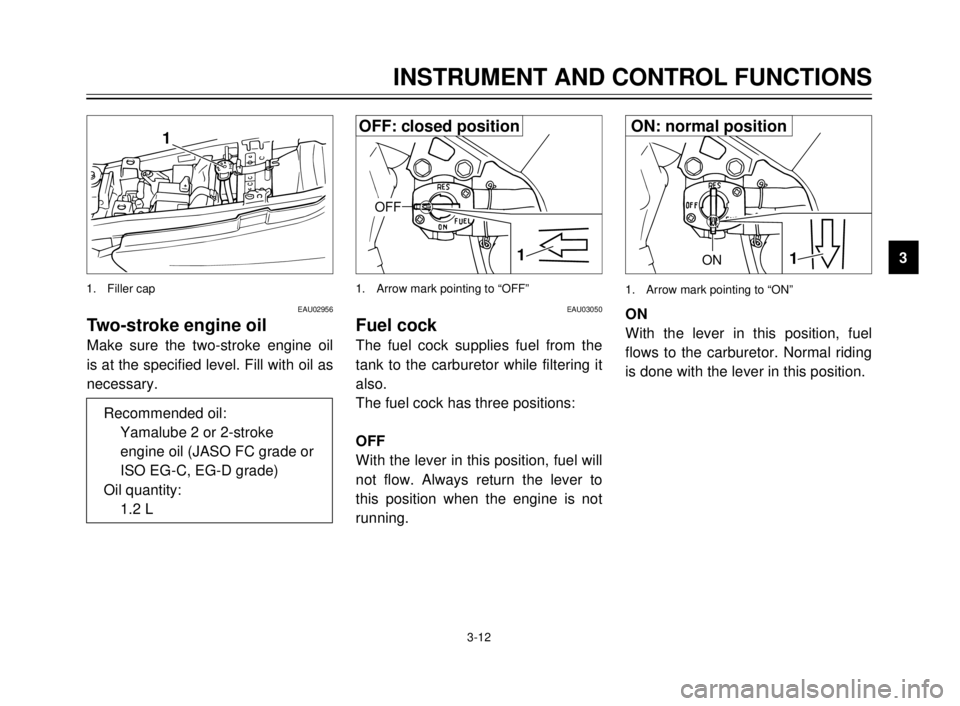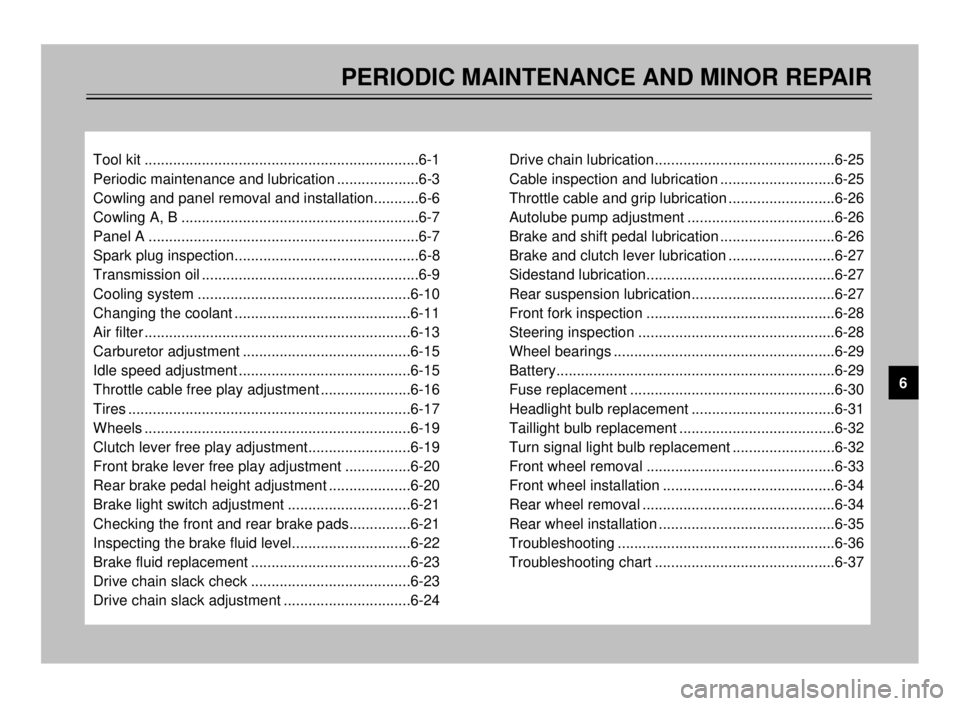2000 YAMAHA TDR 125 oil level
[x] Cancel search: oil levelPage 15 of 104

INSTRUMENT AND CONTROL FUNCTIONS
Main switch/steering lock........................................3-1
Indicator lights ........................................................3-2
Oil level indicator circuit check ...............................3-3
Speedometer ..........................................................3-4
Tachometer ............................................................3-4
Engine temperature gauge .....................................3-5
Handlebar switches ................................................3-5
Headlight beam variation ........................................3-6
Clutch lever.............................................................3-8
Shift pedal...............................................................3-8
Front brake lever ....................................................3-8
Rear brake pedal ....................................................3-9
Fuel tank cap ..........................................................3-9
Fuel.......................................................................3-10
Catalyzer (for Switzerland and Austria) ................3-11
Two-stroke engine oil ...........................................3-12
Fuel cock ..............................................................3-12
Starter (choke) “1” ..............................................3-13
Seat ......................................................................3-13
Helmet holder .......................................................3-14
Rear shock absorber adjustment..........................3-14
Note on handling of the Yamaha Energy
Induction System (Y.E.I.S.) ..................................3-15Y.P.V.S. (Yamaha Power Valve System) .............3-16
Sidestand..............................................................3-16
Sidestand/clutch switch operation check ..............3-17
3
5AE-9-E3 (ENG) 4/11/0 11:06 AM Page 13
Page 17 of 104

3-2
0
0
0100
01000140
180 120 100 80
1 2 3456
7
8
9
10
11
12
~1 000r/minkm/h
CH
12
43
EAU00056Indicator lights
EAU00057Turn indicator light “5 5
”
This indicator flashes when the turn
switch is moved to the left or right.
EAU00061Neutral indicator light “N”
This indicator comes on when the
transmission is in neutral.
EAU00063High beam indicator light “& &
”
This indicator comes on when the
headlight high beam is used.
EAU01313Oil level indicator light “7 7”
This indicator comes on when the oil
level is low. This light circuit can be
checked by the procedure on page
3-3.
EC000000
cC
Do not run the motorcycle until
you know it has sufficient engine
oil.
NOTE:
Even if the oil is filled to the specified
level, the indicator light may flicker
when riding on a slope or during sud-
den acceleration or deceleration, but
this is normal.
1. Turn indicator light “5”
2. High beam indicator light “&”
3. Neutral indicator light “N”
4. Oil level indicator light “
7”
INSTRUMENT AND CONTROL FUNCTIONS
1
2
3
4
5
6
7
8
9
5AE-9-E3 (ENG) 4/11/0 11:06 AM Page 15
Page 18 of 104

3-3
EAU00071
Oil level indicator circuit
check
INSTRUMENT AND CONTROL FUNCTIONS
1
2
3
4
5
6
7
8
9
Oil level indicator light
Check engine oil level. Oil level indicator light
Put the transmission in neutral or apply the
Oil level indicator light
Oil level indicator lightOil levelOil level
Engine oil level and
Ask a Yamaha dealerSupply
Turn the main switch to “ON”
and the engine stop switch to “#”.
does not come on.comes on.
clutch lever, then push the start switch.
comes on. does not come on.
is OK.is low.
engine oil.
to inspect electrical
circuit. electrical circuit are OK.
Go ahead with riding.
5AE-9-E3 (ENG) 4/11/0 11:06 AM Page 16
Page 27 of 104

3-12
INSTRUMENT AND CONTROL FUNCTIONS
1
2
3
4
5
6
7
8
9ON1
1. Arrow mark pointing to “ON”
EAU03050
Fuel cock
The fuel cock supplies fuel from the
tank to the carburetor while filtering it
also.
The fuel cock has three positions:
OFF
With the lever in this position, fuel will
not flow. Always return the lever to
this position when the engine is not
running.ON
With the lever in this position, fuel
flows to the carburetor. Normal riding
is done with the lever in this position.
1
OFF
1. Arrow mark pointing to “OFF”
EAU02956
Two-stroke engine oil
Make sure the two-stroke engine oil
is at the specified level. Fill with oil as
necessary.
1
1. Filler cap
Recommended oil:
Yamalube 2 or 2-stroke
engine oil (JASO FC grade or
ISO EG-C, EG-D grade)
Oil quantity:
1.2 L
OFF: closed positionON: normal position
5AE-9-E3 (ENG) 4/11/0 11:06 AM Page 25
Page 34 of 104

4-1
PRE-OPERATION CHECKS
1
2
3
4
5
6
7
8
9Owners are personally responsible for their vehicle’s condition. Your motorcycle/scooter’s vital functions can start to
deteriorate quickly and unexpectedly, even if it remains unused (for instance, if it is exposed to the elements). Any dam-
age, fluid leak or loss of tire pressure could have serious consequences. Therefore, it is very important that, in addition
to a thorough visual inspection, you check the following points before each ride.
EAU00340PRE-OPERATION CHECK LIST
ITEM CHECKS PAGE
Front brake9Check operation, free play, fluid level and vehicle for fluid leakage.
9Fill with DOT 4 (or DOT 3) brake fluid if necessary.
3-8~3-9, 6-21 ~ 6-24
Rear brake9Check operation, free play, fluid level and vehicle for fluid leakage.
9Fill with DOT 4 brake fluid if necessary.
Clutch9Check operation, condition and free play.
3-8, 6-20 ~ 6-21
9Adjust if necessary.
9Check for smooth operation.
Throttle grip and housing9Lubricate.6-17 ~ 6-18, 6-27
9Adjust throttle cable free play if necessary.
Engine oil9Check oil level.
3-12
9Fill with oil if necessary.
Transmission oil9Check oil level.
6-9 ~ 6-10
9Fill with oil if necessary.
Coolant9Check coolant level.
6-10 ~ 6-11
9Fill with coolant if necessary.
Drive chain9Check chain slack and condition.
6-25 ~ 6-26
9Adjust if necessary.
Wheels and tires9Check tire pressure, wear, damage. 6-18 ~ 6-20
Control and meter cable9Check for smooth operation.
6-27
9Lubricate if necessary.
EAU01114
5AE-9-E3 (ENG) 4/11/0 11:06 AM Page 32
Page 40 of 104

5-3
1. Turn the fuel cock to “ON”.
2. Turn the main switch to “ON” and
the engine stop switch to “#“.
3. Shift transmission into neutral.
NOTE:
When the transmission is in neutral,
the neutral indicator light should be
on. If the light does not come on, ask
a Yamaha dealer to inspect it.
4. Turn on the starter (choke) and
completely close the throttle grip.
5. Start the engine by pushing the
start switch.
NOTE:
If the engine fails to start, release the
start switch, wait a few seconds, then
try again. Each attempt should be as
short as possible to preserve the bat-
tery. Do not crank the engine more
than 10 seconds on any one attempt.
EC000034
cC
The oil level indicator light should
come on when the start switch is
pushed and should go off when
the start switch is released. If the
indicator light flickers or remains
on, immediately stop the engine
and check the engine oil level and
for oil leakage. If necessary, fill the
engine with oil and check to see
that the oil level indicator light
goes off. If the light does not go off
even with sufficient oil in the
crankcase or the light does not
come on when pushing the start
switch, consult a Yamaha dealer.
6. After starting the engine, move
the starter (choke) halfway back.
NOTE:
For maximum engine life, never
accelerate hard with a cold engine!
7. After the engine is warm, turn off
the starter (choke) completely.
NOTE:
The engine is warm when it responds
normally to the throttle with the starter
(choke) turned off.
OPERATION AND IMPORTANT RIDING POINTS
1
2
3
4
5
6
7
8
9
5AE-9-E3 (ENG) 4/11/0 11:06 AM Page 38
Page 45 of 104

PERIODIC MAINTENANCE AND MINOR REPAIR
Tool kit ...................................................................6-1
Periodic maintenance and lubrication ....................6-3
Cowling and panel removal and installation...........6-6
Cowling A, B ..........................................................6-7
Panel A ..................................................................6-7
Spark plug inspection.............................................6-8
Transmission oil .....................................................6-9
Cooling system ....................................................6-10
Changing the coolant ...........................................6-11
Air filter .................................................................6-13
Carburetor adjustment .........................................6-15
Idle speed adjustment ..........................................6-15
Throttle cable free play adjustment ......................6-16
Tires .....................................................................6-17
Wheels .................................................................6-19
Clutch lever free play adjustment.........................6-19
Front brake lever free play adjustment ................6-20
Rear brake pedal height adjustment ....................6-20
Brake light switch adjustment ..............................6-21
Checking the front and rear brake pads...............6-21
Inspecting the brake fluid level.............................6-22
Brake fluid replacement .......................................6-23
Drive chain slack check .......................................6-23
Drive chain slack adjustment ...............................6-24Drive chain lubrication............................................6-25
Cable inspection and lubrication ............................6-25
Throttle cable and grip lubrication ..........................6-26
Autolube pump adjustment ....................................6-26
Brake and shift pedal lubrication ............................6-26
Brake and clutch lever lubrication ..........................6-27
Sidestand lubrication..............................................6-27
Rear suspension lubrication...................................6-27
Front fork inspection ..............................................6-28
Steering inspection ................................................6-28
Wheel bearings ......................................................6-29
Battery....................................................................6-29
Fuse replacement ..................................................6-30
Headlight bulb replacement ...................................6-31
Taillight bulb replacement ......................................6-32
Turn signal light bulb replacement .........................6-32
Front wheel removal ..............................................6-33
Front wheel installation ..........................................6-34
Rear wheel removal ...............................................6-34
Rear wheel installation ...........................................6-35
Troubleshooting .....................................................6-36
Troubleshooting chart ............................................6-37
6
5AE-9-E3 (ENG) 4/11/0 11:06 AM Page 43
Page 50 of 104

6-5
PERIODIC MAINTENANCE AND MINOR REPAIR
6
7
8
9
EVERY
6,000 km 12,000 km
No.
ITEM CHECKS AND MAINTENANCE JOBS
Initialor or
(1,000 km)6 months 12 months
(Whichever (Whichever
comes first) comes first)
9Check operation.
20 * Autolube pump9Correct if necessary.ÖÖÖ
9Bleed if necessary.
9Check oil level and vehicle for oil leakage.
21 Transmission oil9Correct accordingly.
ÖÖÖ
9Change oil at initial 1,000 km and thereafter every
24,000 km or 24 months (whichever comes first).
9Check coolant level and vehicle for coolant leakage.
22 * Cooling system9Correct if necessary.
ÖÖ
9Change coolant every 24,000 km or 24 months (whichever
comes first).
* Since these items require special tools, data and technical skills, they should be serviced by a Yamaha dealer.EAU02970
NOTE
8The air filter needs more frequent service if you are riding in unusually wet or dusty areas.
8Hydraulic brake system
9When disassembling the master cylinder or caliper, always replace the brake fluid. Check the brake fluid level
regularly and fill as required.
9Replace the oil seals on the inner parts of the master cylinder and caliper every two years.
9Replace the brake hoses every four years or if cracked or damaged.
5AE-9-E3 (ENG) 4/11/0 11:06 AM Page 48